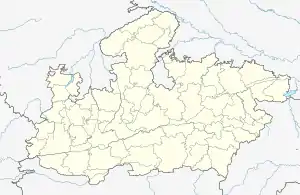Pench National Park
Pench National Park is a national park in India's Madhya Pradesh state, established in 1975 with an area of 257.26 km2 (99.33 sq mi).[1] It includes Pench Tiger Reserve and derives its name from the Pench River that flows through the park from north to south dividing the park into almost equal western and eastern halves, the well-forested areas of Seoni and Chhindwara districts respectively. It was declared a sanctuary in 1965, raised to the status of national park in 1975 and enlisted as a tiger reserve in 1992.
| Pench National Park | |
|---|---|
| Indira Priyadarshni National Park | |
IUCN category II (national park) | |
 | |
| Location | Madhya Pradesh, India |
| Nearest city | Seoni |
| Coordinates | 21°40′17.76″N 79°18′11.88″E |
| Area | 257.26 km2 (99.33 sq mi)[1] |
| Established | 1975 |
| Governing body | State Forest Department |
| Website | penchtiger.co.in |
The national park consists of dry deciduous forests and much fauna and flora including tigers, various types of deer and birds.[2] In 2011, the park won the "Best Management Award". This park is accessible from Pauni on National Highway 7 and has two famous entry gates, Turiya and Karmajhiri.[3]
History
The area of the present Pench Tiger Reserve has been described in Ain-i-Akbari, and is the setting of Rudyard Kipling's The Jungle Book.[4]
Features
Pench National Park comprises 758 km2 (293 sq mi), out of which 299 km2 (115 sq mi) form a core, the Pench National Park core area and Mowgli Pench Sanctuary. The remaining 464 km2 (179 sq mi) form the buffer zone.
The protected area is covered with small hills and well-stocked teak mixed forest in the southern reaches of the Satpura Ranges. Elevation ranges from 425 to 620 m (1,394 to 2,034 ft). The temperature varies from 4 °C (39 °F) in December to 42 °C (108 °F) in May. Average rainfall is 1,300 mm (51 in).
Vegetation
The forest cover in the park area includes teak mixed with other species like saja, bijiayasal, lendia, haldu, dhaora, salai, amla, amaltas. The ground is covered with maze of grasses, plants, bushes and saplings. Bamboo is also found at places. Scattered white kulu trees, also referred to as 'ghost tree', stand out conspicuously among the various hues of green. Another important tree for both wildlife and tribal people of this region is mahua. The flowers of this tree are eaten by mammals and birds, and also harvested by the tribal people as food and to brew beer.
Wildlife
The Bengal tiger is the main cat species of the park present in good numbers but since last one year due to 6 new born cubs their sightings have increased and being sighted almost everyday. As per latest Tiger Census, there are approx. 40 tigers in the park, 39 species of mammals, 13 species of reptiles, 3 species of amphibians. Commonly seen wildlife is chital, sambar, nilgai, wild boar, and jackal. Also Indian leopard, sloth bear, indian wolf, wild dog, porcupine, monkey, jungle cat, fox, striped hyena, gaur, four-horned antelope and barking deer live in the park.
The park is rich in bird life too. According to an estimate of the wildlife authorities, the park harbours more than 210 species including several migratory ones. Some of them are peafowl, junglefowl, crow pheasant, crimson-breasted barbet, red-vented bulbul, racket-tailed drongo, Indian roller, magpie robin, lesser whistling teal, pintail, shoveller, egret and herons, minivet, oriole, wagtail, munia, myna, waterfowl and common kingfisher.
Visiting times and nearest station
The best time to visit the park is between November and May. The park is open to visitors between 6 am and 10:30 am and between 3 pm and 6 pm. The park remains closed during July, August and September. The park can be accessed by road and railway. The nearest airport, railway station is Dr. Babasaheb Ambedkar International Airport, Nagpur and closest city is Seoni, bus can be taken to the park. Turiya is the nearest highway stop near Pench. Open jeep safaris are allowed from each of the gates twice in a day, with a fixed quota for each gate, for each schedule. Elephant safaris used to be conducted at one time, but have been discontinued these days.
In popular culture
Pench forest reserve, is one of the places that may have inspired Rudyard Kipling's The Jungle Book.[5]
The Pench National Park provided the location used by the BBC for the innovative wildlife series Tiger: Spy in the Jungle, a three-part documentary narrated by Sir David Attenborough which used concealed cameras, placed by elephants, in order to capture intimate tiger behavior and also retrieved footage of various other fauna in the reserve. The programme aired for the first time in March 2008 and ended a month later.
References
- World Database on Protected Areas (2019). "Pench National Park". Protected Planet.
- "Birds of Pench". www.inditales.com. Retrieved 5 March 2019.
- "Experiences at Pench national park - a blog". www.imvoyager.com. Retrieved 4 March 2019.
- "MPT - Madhya Pradesh Tourisum". www.mptourism.com. Retrieved 11 June 2016.
- Andres, Trisha (15 April 2016). "The Jungle Book: 5 best tours to Rudyard Kipling's India". The Telegraph. Retrieved 11 December 2017.
External links
| Wikimedia Commons has media related to Pench National Park. |
- Pench National Park - Madhya Pradesh Tourism Board